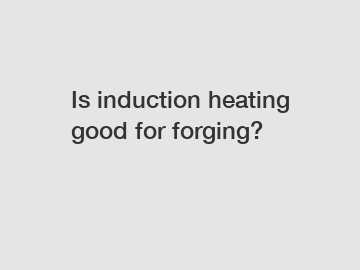Is induction heating good for forging?
Is Induction Heating Good for Forging?
Induction heating is a cutting-edge technology that has revolutionized the forging industry. It utilizes the principle of electromagnetic induction to heat up metallic materials quickly and efficiently. But does this advanced technique live up to its hype? Is induction heating truly good for forging? Let's delve into the topic and explore the advantages and disadvantages of using induction heating in the forging process.
1. Fast and Efficient Heating:

One of the major benefits of induction heating for forging is its remarkable speed. Induction heating can rapidly raise the temperature of metals, allowing them to reach their optimal forging temperatures within seconds. The speed and efficiency of this process minimize production time and increase overall throughput. Induction heating excels in achieving precise and repeatable heating, ensuring consistent quality in the forgings.
2. Uniform Heating:
Induction heating offers excellent control over the temperature distribution within the workpiece. With traditional heating methods, such as gas or open flame, the heat tends to concentrate towards the outer surface of the material, leading to uneven heating. In contrast, induction heating evenly distributes heat throughout the entire workpiece, resulting in uniform physical properties and a reduction in material waste. This capability makes induction heating particularly suitable for complex forging shapes with intricate designs.
3. Enhanced Precision:
For certain forging applications, precision is crucial. Induction heating provides precise control over temperature, which is essential for achieving the desired characteristics and mechanical properties of the final product. The ability to precisely control the heating process offers greater flexibility in meeting specific requirements, whether it be the grain size, hardness, or dimensional accuracy. This level of precision translates into improved product quality and increased customer satisfaction.
4. Energy Efficiency:
Induction heating is known for its energy-efficient nature. Unlike traditional heating methods, which often result in significant heat losses through radiation or convection, induction heating directly transfers energy to the workpiece through electromagnetic induction. This direct heat transfer minimizes energy losses and maximizes the amount of energy utilized for the forging process. By reducing energy consumption and related costs, induction heating presents an environmentally friendly and cost-effective solution for forging operations.
Despite its numerous advantages, induction heating for forging also has some limitations and challenges worth considering:
1. Initial Investment:
While induction heating offers long-term cost savings, the initial investment required to acquire and set up the necessary equipment can be substantial. The specialized machinery, including power supplies, induction coils, and controllers, can require a considerable financial commitment. However, the increased efficiency and reduced operating costs over time often justify this initial expense, especially for high-volume forging operations.
2. Limited Heat Depth:
One limitation of induction heating is its relatively shallow heat penetration depth. This can restrict its use in certain forged components that require deep and uniform heating throughout. However, by employing innovative coil designs and optimizing process parameters, it is possible to overcome this limitation to some extent. Each forging project must be carefully assessed to determine whether induction heating suits the specific requirements.
3. Material Selection:
Although induction heating is widely applicable to various types of metals, certain materials may not respond well to this heating method. Non-conductive materials, such as ceramics or plastics, are unsuitable for induction heating. Additionally, materials with low magnetic permeability may require extra attention or modifications to ensure effective heating. It is crucial to consider material compatibility when deciding whether induction heating is appropriate for a specific forging application.
In conclusion, induction heating undeniably offers significant advantages for forging operations. Its rapid and efficient heating, uniform temperature distribution, enhanced precision, and energy efficiency make it an excellent choice for many industrial applications. However, the substantial initial investment, limited heat depth, and material compatibility concerns should also be taken into account when implementing induction heating for forging. Careful evaluation and selection of suitable equipment and materials can help harness the full potential of induction heating, ultimately leading to improved productivity and high-quality forgings.
For more induction heating aluminium, forging with induction heating, induction brazing systeminformation, please contact us. We will provide professional answers.

Comments